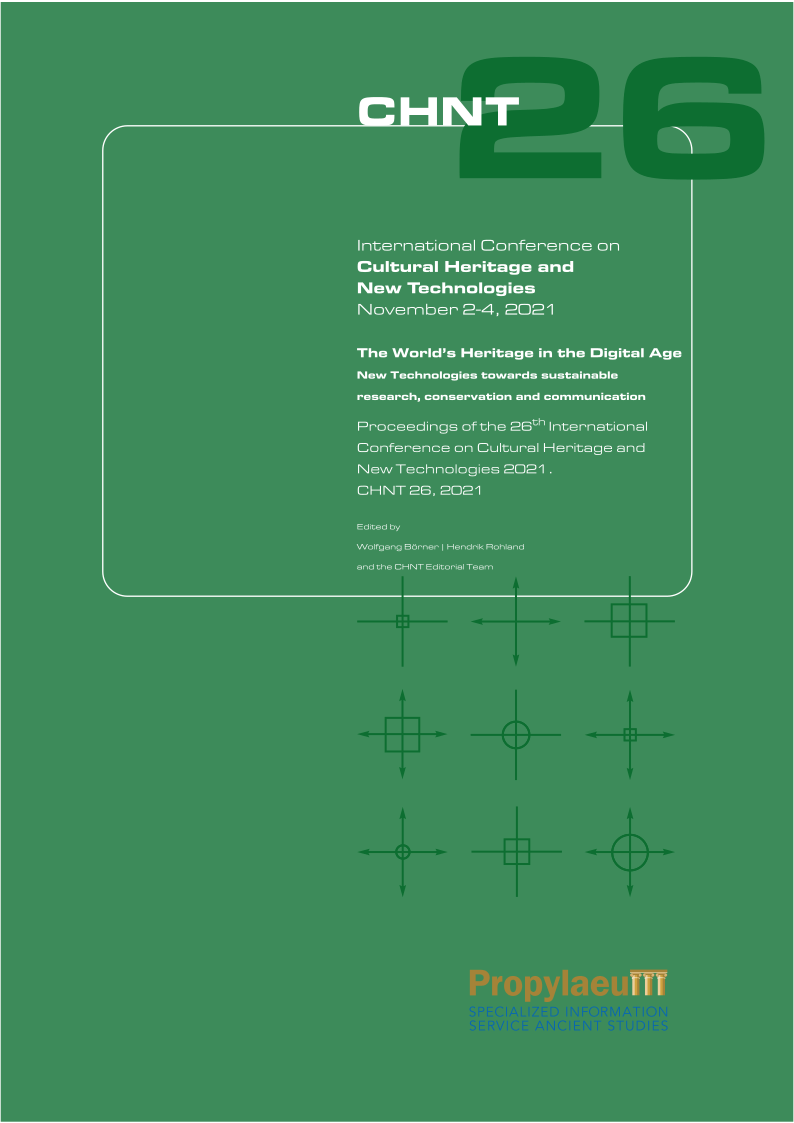Views on ancient lighting
Modelling lighting devices and their effects in architecture
Keywords:
luminaire modelling, Artificial illumination, Lychnology, Lighting simulationAbstract
Lighting is the practise of the deliberate, often combined, utilisation of daylight and other lighting devices to illuminate the human environment. Its effects can be reconstructed employing computational simulation from archaeological evidence, the findings of historical building research, and other sources. Methods of describing flames as the primary source of pre-modern artificial lighting in lighting simulation have to be developed. Exemplary lighting devices and research questions with regards to their interplay with their architectural contexts are discussed. The paper presents preliminary results and lines of thought emerging from the authors’ ongoing interdisciplinary research in lighting devices, lighting practice, and its effects on pre-modern architecture.
References
Çakmakcı, Z. (2008). Örnekler ışığında Bizans Asia'sında cam sanatı. PhD. Ege University. Available at: https://acikerisim.ege.edu.tr/xmlui/handle/11454/3686 (Accessed: 10 January 2022).
Devlin, K. and Chalmers, A. (2001). ‘Realistic visualisation of the Pompeii frescoes’, in Proceedings of the 1st International Conference on Computer Graphics, Virtual Reality and Visualisation, Cape Town, South Africa, March 2001. New York, USA: Association for Computing Machinery, pp. 43 – 48. https://dx.doi.org/10.1145/513867.513878
Doulos, L., Moullou, T. and Topalis, F.V. (2019). ‘Lux in vitro: Artificial lighting conditions in houses of antiquity’, Ancient lamps from Balkans and beyond, Ex Oriente Lux: 4. International Lychnological Congress, Ptuj, Slovenia, May 2012. Drémil Lafage, France: Editions Mergoil, pp. 15 – 19.
Motsianos, I. and Garnett, K.S. (eds.) (2019). Glass, wax and metal: Lighting technologies in late antique, Byzantine and medieval times, Oxford, United Kingdom: Archaeopress Publishing.
Grobe, L.O., Noback, A., Lang, F., Schintlmeister, L., and Schwaiger, H. (2021). ‘Daylight scattering by late antique window glass from Ephesos: Reconstructing the spatial distribution of daylight in lost architecture’, in Monumental Computations: Digital archaeology of large urban and underground infrastructures, CHNT24. Vienna, Austria, September 2019. Heidel-berg, Germany: Propylaeum, pp. 317 – 334. https://dx.doi.org/10.11588/propylaeum.747.c11798
Gruber, E. (2015). ‘3D models als analytical tools’, in Olson, B.R. and Caraher, W.R. (eds.) Visions of substance: 3D imag-ing in Mediterranean archaeology. Grand Forks (USA): The digital press, pp. 63 – 72.
Happa, J., et al. (2010). ‘Illuminating the past: State of the art’, Virtual Reality, 14(3), pp. 155 – 182. https://dx.doi.org/10.1007/s10055-010-0154-x
Happa, J. and Artusi, A. (2020). ‘Studying illumination and cultural heritage’, in Liarokapis, F., Voulodimos, A., Doulamis, N., and Doulamis, A. (eds.) Visual computing for cultural heritage. Cham, Switzerland: Springer, pp. 23 – 42. https://doi.org/10.1007/978-3-030-37191-3
Henkelmann, V. (2018), ´Der Marienleuchter in St. Lorenz Nürnberg´, in: 500 Jahre Engelsgruß in St. Lorenz Nürnberg. Lin-denberg im Allgäu, Germany: Kunstverlag Josef Fink, pp. 45 – 62.
Henkelmann, V. (2020). ‘Die spätmittelalterliche Lichtinszenierung an St. Lorenz in Nürnberg’, Mitteilungen des Vereins für Geschichte der Stadt Nürnberg, 107, pp. 97 – 134.
Kider, J.T., et al. (2009). ‘Recreating early Islamic glass lamp lighting’, International Symposium on Virtual Reality, Archaeol-ogy and Cultural Heritage, St. Julians, Malta, September 2009. Goslar, Germany: Eurographics Association, pp. 33 – 40. https://dx.doi.org/10.2312/VAST/VAST09/033-040
Lassandro, P., Fioriello, C.S., Lepore, M., and Zonno, M. (2021). ‘Analysing, modelling and promoting tangible and intangible values of building heritage with historic flame lighting system’, Journal of Cultural Heritage, 47, pp. 166 – 179. https://dx.doi.org/10.1016/j.culher.2020.09.013
Noback, A., Grobe, L.O. and Inanici, M. (2020). ‘Hagia Sophia’s sixth century daylighting’, International Hagia Sophia Sym-posium, Istanbul, Turkey, August 2020. Istanbul, Turkey: Fatih Sultan Mehmet Vakıf University, pp. 687 – 706. https://dx.doi.org/10.5281/zenodo.4322666
Papadopoulos,C. and Moyes, H. (2021). ‘Illuminating sensory archaeologies’, in Papadopoulos, C. and Moyes, H. (eds.) The Oxford handbook of light in archaeology. Oxford, United Kingdom: Oxford University Press, pp. 1 – 15. https://dx.doi.org/10.1093/oxfordhb/9780198788218.001.0001
Schoueri, K.G., and Teixeira-Bastos, M. (2020). ‘A theoretical framework for informal 3D rendered analysis of the Roman lararium from Apollonia-Arsuf’, Open Archaeology, 7(1), pp. 499 – 518. https://doi.org/10.1515/opar-2020-0148
Ward, G. (1994). ‘The Radiance lighting simulation and rendering system’, in Computer Graphics Proceedings, pp. 459 – 472. https://doi.org/10.1145/192161.192286
Weisbuch, C. (2018). ‘Historical perspective on the physics of artificial lighting’, Comptes Rendus Physique, 19(3), pp. 89 – 112. https://doi.org/10.1016/j.crhy.2018.03.001
Downloads
Published
Conference Proceedings Volume
Section
License
Copyright (c) 2025 Lars Oliver Grobe, Andreas Noback, Ruth Bielfeldt, Vera Henkelmann, Franziska Lang

This work is licensed under a Creative Commons Attribution-ShareAlike 4.0 International License.
The CHNT older Proceedings are licensed under the creative commons license CC BY-NC-ND 3.0.
From the issue 26 on, they will be licensed under the creative commons license CC-BY-SA 4.0


